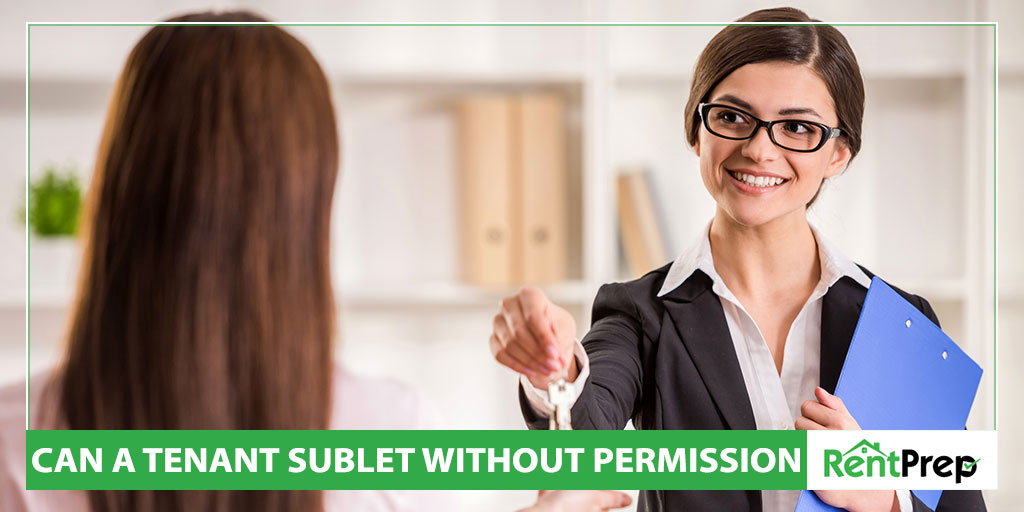
At times, you may find that subleases can be a great way to bridge the gap between a broken lease and a long vacancy period. There are situations, however, when tenants will skip official protocol for an unofficial roommate or renter. Can a tenant sublet without permission?
Landlords who realize their tenant is subletting an apartment without permission will be confused about their next step. What do you do when you want to keep your property rented, but you want to be sure things are being handled properly? Avoiding the issue can cause legal trouble down the line, so you should address the problem quickly.
Many tenants find subletting to be a non-problem because they do not realize the associated risks and problems that are created for landlords. Today, we’ll talk about what to do when your tenant is illegally subletting and how subletting can be handled.
A Table Of Contents On Tenant Subletting
- What Is Subletting?
- The Pros And Cons Of Subletting
- My Tenant Is Subletting Without Permission: Now What?
- Sublease Terms: Put It In The Lease!
- Tenant Subletting FAQs
What Is Subletting?

What exactly is subletting, and why is it a concern for landlords and tenants?
A sublease is a lease that happens between a tenant and a new “subtenant” who will be taking over part or all of the rental property for a specific amount of time. While this lease agreement is separate from the original lease agreement, the two leases typically have some amount of interaction between them.
The exact terms and structure of a sublease will differ from situation to situation. While you can require a standard sublease to be used by tenants, most will have some amount of variation due to the variety of circumstances that may lead to subletting.
Additionally, the rules about subletting vary from state to state. States that don’t mention subletting at all leave the terms up to the lease agreement, while other states have specific subletting rules.
Subletting Procedure
When subletting is handled properly, the following steps are typically going to be taken by all parties involved.
Screening Should Happen
While tenants are going to be responsible for finding a subtenant to take over their lease, you should be involved in the screening process. As with any other tenant who will live at your property, you have a right to ensure they are going to be reliable and take care of the property.
Subtenants should go through the same tenant screening process as any other tenant you are considering. Any tenant or potential subtenant who doesn’t agree with this policy should not be considered.
As the landlord, you have the right to make the final call about any subtenant who wants to sign on with a sublease.
Permission Must Be Given
As long as it is included in your original lease agreement, tenants will need to have your consent to set up a sublease. The sublease is a document binding your tenant to the subtenant, but this document is not legally binding without your written permission.
Rent Payment Clarity
One of the most important parts of setting up a sublet situation is to ensure rent payments will be paid on time and through the proper channels. Whether the subtenant pays you directly or pays the tenant who, in turn, pays you will depend on the sublease terms. Regardless, your tenant holds the final financial responsibility for the rent.
The Pros And Cons Of Subletting
There are both benefits and drawbacks to allowing subletting.
On the positive end of things, subletting can ensure:
- The property is not left vacant
- Rent keeps coming in
- There is no need to involve courts or evict
- Better tenant relations
- Empathy shown to tenants who need to move but don’t want to break the lease
On the flip side, however, there can also be some drawbacks:
- Subtenants can cause problems
- Holding tenants accountable for the actions of subtenants creates more work
- Time and effort to coordinate
Ultimately, you are the only one who can decide if you are in favor of subletting or not. Allowing sublets with permission is usually the path many landlords choose to take, especially in areas where college students live.
My Tenant Is Subletting Without Permission: Now What?
Now that we’ve covered the basics of subletting and how it works, let’s talk about what to do when one of your tenants is subletting without your permission.
#1 Enforce Your Policy

If your tenant did not get your permission to sublet and you have a sublet clause in your lease, they have officially broken the lease. This means you can send out a notice to comply or vacate the property.
Subletting without permission is cause for eviction, but you aren’t required to evict the tenant. Instead, you could simply use the notice to encourage the tenant to follow the policy.
Sending a notice that requests the tenant follow the sublet clause, as outlined in the original lease agreement, within a certain number of days is a good next step. By doing this, the property will remain occupied, but you will also be ensuring the necessary legal documents are in place for the sublet.
#2 Talk To The Subtenant
Talking to the subtenant to find out the details of the arrangement between the tenant and subtenant is key. There have been cases where a subtenant is not aware that the tenant is not the landlord, and that can lead to a lot of problems.
When a subtenant doesn’t know who the actual landlord is, it is unlikely that problems will be addressed and repaired as they should be. This can be very bad for your rental property.
Simply speaking with the subtenant, if possible, can be very enlightening to help you determine how to proceed with the situation.
#3 Evict Your Tenant
If your tenant has sublet without permission and subletting is expressly forbidden or you simply do not trust them to comply, you can file for eviction. In most states and cities, a tenant subletting without permission is going to be a strong enough case for eviction as long as the lease is clear about subletting terms.
As soon as you find out about the illegal subletting, send out an official notice of eviction, and begin the eviction process. From there, you can regain full control and use of your property without worry about illegal subletters.
#4 Let Them Be
This is not the recommended action in our eyes, but there are some landlords who will find this to be the best solution. If you find out your tenant has been subletting one room in the apartment for three months without any issues, you might be tempted to let them continue this pattern.
This situation could turn out good or bad, but we prefer to encourage landlords to err on the side of caution. Even if you are OK with the subletting continuing, it is best to get yourself officially involved to prevent any problems down the line.
Sublease Terms: Put It In The Lease!
No matter what your feelings are about subletting, all landlords should agree that including a sublet clause in your lease agreement template is a necessity!
Sublet clauses can take on numerous directions depending on your needs:
- Forbid sublets outright
- Allow sublets, with landlord permission
- Allow limited sublets under specific circumstances
- Allow sublets at any time
Many landlords keep their sublease clause direct, for example, “the tenant may not sublet the rental property unless I give written permission”. In turn, you must not unreasonably deny a tenant permission to sublet in states where subletting is a legal right.
How you structure your sublease clause is up to you, but you want to be sure this clause is included in your lease. In states without any specific rules on subletting, the lease will be used as the final word on all matters surrounding subletting, so you will want this section to be thorough if you live in one of those states.
While not required, it is also a good idea to put in some more specific terms about how sublets will be structured in the sublease clause. By determining these things in advance and using them for your lease template, you won’t need to spend time sorting out the details later. The structure for subletting will already exist.
Tenant Subletting FAQs
Can My Tenant Sublet A Room Without Permission?
No; tenants cannot sublet any rooms in a rental property without following the proper procedure as outlined in the lease. The only exception would be if a landlord has previously given consent for subleasing, but most landlords will need to be involved in the subletting process for it to be official.
Even in states where subletting is required, landlords are allowed to require that the tenant get their consent before subletting. Landlords are, in turn, required to not unreasonably deny any sublet requests in these states. Reasonable denials can be given for subtenants who do not meet the screening qualifications of the landlord.
Why Is Subletting Not Allowed At Some Properties?
The most common reason for not allowing subletting at a property is the increased risk of financial loss, property damage, or misleading tenants. Adding more tenants or switching tenants through a sublease during a tenancy adds work and risk for the landlord. This added risk can cause landlords to forbid subletting when permitted to do so.
Is Subletting A Tenant’s Right?
In some states and cities, landlord-tenant laws do not permit landlords from forbidding subletting. It is a tenant’s right, in these areas, to sublet their rental as long as they follow the procedure in their lease agreement.
If you are a landlord operating in a state where subletting can be prohibited, you can add these terms to your lease. In Massachusetts, for example, subletting is only allowed when the landlord consents.
What Happens If A Sublet Doesn’t Pay Rent?
The terms of the sublease agreement between the landlord, tenant, and subtenant should clarify who will be held responsible for the rent. Depending on who the lease declares responsible, you can then pursue rent collection with a notice of nonpayment of rent.
If your property has been sublet illegally, the original tenant is still responsible for all rent.
Is A Sublease Legally Binding?
Subleases, when used correctly, are legally binding contracts between the tenant and the subtenant, which outline the transfer of the use of the property between these two parties.
In most cases, a sublease is only legally binding when the landlord who owns the property has given permission for the sublease. This is because lease agreements typically require this type of consent for subletting to occur.
Can A Landlord Sue A Subtenant?
The answer to this question will depend on the structure of the original lease and sublease. In most cases, the landlord would be more likely to sue the master, or original, tenant. This is because the rights and responsibilities of tenancy remain largely with the original tenant.
Can A Tenant Sublet Without Permission?
As with many parts of rental property ownership, understanding how subletting works can be confusing. Is my tenant subletting illegally? Is there something specific I need to do about that? Should I allow subletting to continue?
These are all common, and reasonable, questions for you to have when dealing with a tenant subletting without permission.
Stay organized to prevent future confusion:
- Add a sublet clause to your lease agreement for clarity.
- Always enforce the sublet clause.
- Consider evicting tenants that sublet without permission.
- Make sure you are familiar with local and state subletting rules.
As long as you are informed about these four points, you will be ready to take action when faced with sublet situations. Subletting can be very beneficial depending on the areas where you are working, but it should always be done with your consent as the property owner. Make sure to enforce that rule moving forward!

